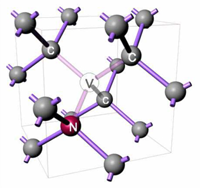Diamond
Our research pro ject aims to characterize and exploit the remarkable quantum properties of defect centers in diamond. These tiny impurities in the diamond crystal not only give rise to a wide range of crystal colors, but also show great potential for basic research in quantum mechanics (quantum computers, quantum communication) as well as for building very sensitive magnetic field sensors (for use e.g. in the life sciences).
ject aims to characterize and exploit the remarkable quantum properties of defect centers in diamond. These tiny impurities in the diamond crystal not only give rise to a wide range of crystal colors, but also show great potential for basic research in quantum mechanics (quantum computers, quantum communication) as well as for building very sensitive magnetic field sensors (for use e.g. in the life sciences).
Among hundreds of known impurity defects in diamond crystals, especially the Nitrogen-Vacancy (NV) center has been shown to exhibit remarkably stable and long-lived quantum behaviour even at room temperature. Over the past few years, physicists around the world have isolated single NV centers in high-resolution microscopes, analyzed their light-emitting behaviour (fluorescence) and manipulated their quantum states by using pulsed microwave techniques (spin resonance).
 An NV center can be thought of as a single molecule “trapped” inside a crystal, which makes it rather easy to handle experimentally as compared to free particles. Nevertheless, an NV center – just like a single atom – emits only one light quantum at a time (single photon emission) and remains in well-defined quantum superposition states (analogous to Schrödinger’s cat) for time spans up to milliseconds – in spite of its vibrating and noisy environment in a room-temperature crystal.
An NV center can be thought of as a single molecule “trapped” inside a crystal, which makes it rather easy to handle experimentally as compared to free particles. Nevertheless, an NV center – just like a single atom – emits only one light quantum at a time (single photon emission) and remains in well-defined quantum superposition states (analogous to Schrödinger’s cat) for time spans up to milliseconds – in spite of its vibrating and noisy environment in a room-temperature crystal.